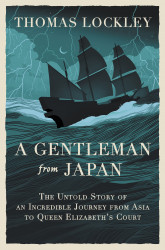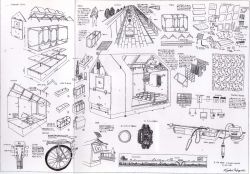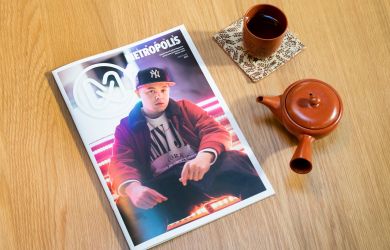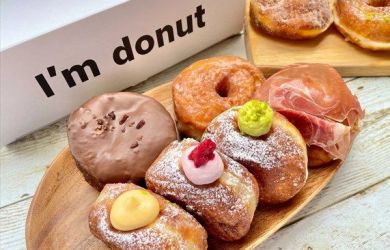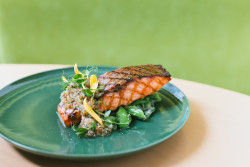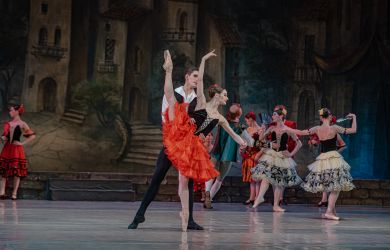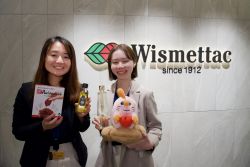
Originally published on metropolis.co.jp on September 2009

Photos by Dan Grunebaum
Canine eyes gleam at us from the roadside as we exit the airport into the tropical darkness of Koror, the nondescript hub of the Republic of Palau.
A Micronesian archipelago halfway between Guam and the Philippines, Palau is one of the world’s youngest and smallest nations. Unlike the overwhelmed peoples of neighboring islands like Guam, its natives still seem to be masters of their own destiny, and it’s refreshing to hear them speaking their language and observing their traditions, a blend of Polynesian, Melanesian and Asian influences.
But it isn’t the culture we’ve come for—it’s the country’s legendary Rock Islands. Before we can get there, however, we have to wait for the rain to clear. This is Palau’s dry season, but the nation gets 380cm of rain a year, and its lush green hills spend most of the time draped in clouds. We sit in our charming hilltop bungalow and watch the government-restricted satellite TV service instead.
As luck would have it, on the day we’ve planned a snorkeling tour to the Rock Islands, the weather breaks. Palau is famous for the biodiversity of its reefs, and we pull up at Sam’s Tours amid a bustle of leathery divers from around the world. Accompanying us will be the redoubtable Malahi, a veteran Palauan guide who has spent the last two decades finding the archipelago’s sweetest dive spots—and raising five children.
Pushing off in a powerboat, we make our first stop at the aptly named Milky Way. Formed by the leaching of ancient coral from limestone outcroppings that were pushed into the air by volcanic action, it’s a flawless lagoon of powder-blue sea surrounded by jungle-clad islands. We’re soon floating in its saline waters and rubbing ourselves down with sulfurous white clay.

The rest of our day is spent wending among the Rock Islands, which hang like an emerald necklace from Palau’s main island of Babeldaob. The islands stretch south for 50km, ending in Peleliu, the site of some of the most vicious combat of WWII. One perfect sandy shore is even dubbed “Lee Marvin beach,” as it was used in the 1968 movie Hell in the Pacific, starring the gravel-voiced actor and Japan’s Toshiro Mifune.
Palau is also famed for its “jellyfish lakes.” As the porous limestone of the islands eroded, bodies of water formed in their interiors. The permeability of the rock allowed seawater—and tiny jellyfish eggs—to seep in, and without natural predators the gelatinous creatures blossomed, losing their venom in the process.
The experience of snorkeling through a constellation of jellyfish welling up from the deep is at once mystical and discomfiting. This is lost on my 3-year-old son, however. The sight of brazen, circling reef sharks at the next snorkel spot also goes to waste on him—though it’s something I’ll never forget.
Two more days of rain leave us at a loose end, so we spend some time meandering around Koror’s historical museum, where we are the only visitors. No written language existed to record Palau’s history, but the country was inhabited at least as far back as 1000 BC. The famous stone money of Yap was mined here and exported by canoe. Palau is also noted for its matrilineal society, which was documented by the Europeans who first arrived in the 1700s. It was English Captain Henry Wilson who, shipwrecked here in 1783, dubbed the archipelago the “Pelew Islands.”
The last day of our trip starts out sunny, and the panorama from our deck perfectly sums up why Palau calls itself “the end of the rainbow.” We end our visit kayaking through tranquil lagoons, suspended between the birdcalls above and the multihued fish darting below. Then, after a brief evening nap, we venture back into the night to the airport: the only flight to Guam leaves at 2:30am.
Trip Tips
Continental Micronesia (www.continental.com) has flights to Palau via Guam, while JAL runs a direct charter service (www.jal.co.jp/intltour). Most hotels are located on Koror, where the Palau Pacific Resort (www.palauppr.com) occupies one of the only beaches, and The Carolines Resort (www.carolinesresort.com) has hillside bungalows.. There is a maritime tropical climate, with little seasonal variation. Expect high precipitation throughout the year, and typhoons from June to November. If you’re looking to go scuba diving, Sam’s Tours (www.samstours.com) and Fish ‘n Fins (www.fishnfins.com) are two of the biggest dive shops.
[geo_mashup_map]

